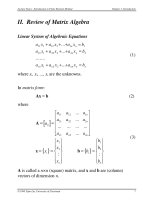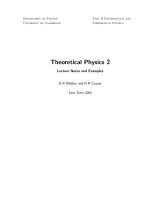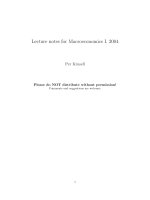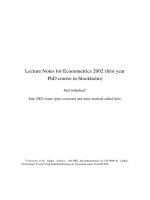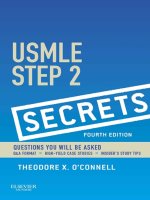USMLE step 2 CK lecture notes 2019 surgery (2019)
Bạn đang xem bản rút gọn của tài liệu. Xem và tải ngay bản đầy đủ của tài liệu tại đây (5.64 MB, 494 trang )
USMLE®STEP2CKSURGERY
LectureNotes
2019
TableofContents
USMLEStep2CKLectureNotes2018:Surgery
Cover
TitlePage
Copyright
Editors
FeedbackPage
PartI:Surgery
Chapter1:Trauma
PrimarySurvey:TheABCs
AReviewfromHeadtoToe
Burns
BitesandStings
Chapter2:Orthopedics
PediatricOrthopedics
AdultOrthopedics
Tumors
Chapter3:Pre-OpandPost-OpCare
PreoperativeAssessment
PostoperativeComplications
Chapter4:GeneralSurgery
DiseasesoftheGastrointestinalSystem
DiseasesoftheBreast
DiseasesoftheEndocrineSystem
SurgicalHypertension
Chapter5:PediatricSurgery
Birth—First24Hours
AFewDaysOld—First2MonthsofLife
LaterinInfancy
Chapter6:CardiothoracicSurgery
CongenitalHeartProblems
AcquiredHeartDisease
Lung
Chapter7:VascularSurgery
Chapter8:SkinSurgery
Chapter9:Ophthalmology
Children
Adults
Chapter10:Otolaryngology(ENT)
NeckMasses
OtherTumors
PediatricENT
ENTEmergenciesandMiscellaneous
Chapter11:Neurosurgery
DifferentialDiagnosisBasedonPatientHistory
VascularOcclusiveDisease
BrainTumor
PainSyndromes
Chapter12:Urology
UrologicEmergencies
CongenitalUrologicDisease
Tumors
RetentionandIncontinence
Stones
Miscellaneous
Chapter13:OrganTransplantation
PartII:SurgicalVignettes
Chapter1:Trauma
PrimarySurvey:TheABCs
AReviewfromHeadtoToe
Burns
BitesandStings
Chapter2:Orthopedics
PediatricOrthopedics
AdultOrthopedics
Tumors
Chapter3:Pre-OpandPost-OpCare
PreoperativeAssessment
PostoperativeComplications
Chapter4:GeneralSurgery
DiseasesoftheGastrointestinalSystem
DiseasesoftheBreast
DiseasesoftheEndocrineSystem
SurgicalHypertension
Chapter5:PediatricSurgery
AtBirth—TheFirst24Hours
AFewDaysOld—TheFirst2MonthsofLife
LaterinInfancy
Chapter6:CardiothoracicSurgery
CongenitalHeartProblems
AcquiredHeartDisease
Lung
Chapter7:VascularSurgery
Chapter8:SkinSurgery
Chapter9:Ophthalmology
Children
Adults
Chapter10:Otolaryngology(ENT)
NeckMasses
OtherTumors
PediatricENT
ENTEmergenciesandMiscellaneous
Chapter11:Neurosurgery
VascularOcclusiveDisease
BrainTumor
SpinalCord
PainSyndromes
Chapter12:Urology
UrologicEmergencies
CongenitalUrologicDisease
Tumors
RetentionandIncontinence
Stones
Miscellaneous
Chapter13:OrganTransplantation
USMLE®isajointprogramoftheFederationofStateMedicalBoards(FSMB)andtheNationalBoardof
MedicalExaminers(NBME),neitherofwhichsponsorsorendorsesthisproduct.
Thispublicationisdesignedtoprovideaccurateinformationinregardtothesubjectmattercoveredasofits
publicationdate,withtheunderstandingthatknowledgeandbestpracticeconstantlyevolve.Thepublisher
isnotengagedinrenderingmedical,legal,accounting,orotherprofessionalservice.Ifmedicalorlegal
adviceorotherexpertassistanceisrequired,theservicesofacompetentprofessionalshouldbesought.This
publicationisnotintendedforuseinclinicalpracticeorthedeliveryofmedicalcare.Tothefullestextentof
thelaw,neitherthePublishernortheEditorsassumeanyliabilityforanyinjuryand/ordamagetopersons
orpropertyarisingoutoforrelatedtoanyuseofthematerialcontainedinthisbook.
©2018byKaplan,Inc.
PublishedbyKaplanMedical,adivisionofKaplan,Inc.
750ThirdAvenue
NewYork,NY10017
AllrightsreservedunderInternationalandPan-AmericanCopyrightConventions.Bypaymentofthe
requiredfees,youhavebeengrantedthenon-exclusive,non-transferablerighttoaccessandreadthetextof
thiseBookonscreen.Nopartofthistextmaybereproduced,transmitted,downloaded,decompiled,reverse
engineered,orstoredinorintroducedintoanyinformationstorageandretrievalsystem,inanyformorby
anymeans,whetherelectronicormechanical,nowknownorhereinafterinvented,withouttheexpress
writtenpermissionofthepublisher.
ISBN-13:978-1-5062-3633-9
EDITORS
CarlosPestana,MD,PhD
EmeritusProfessorofSurgery
UniversityofTexasMedicalSchoolatSanAntonio
SanAntonio,TX
AdilFarooqui,MD,FRCS
ClinicalAssistantProfessorofSurgery
KeckSchoolofMedicine,UniversityofSouthernCalifornia
KaiserPermanente,WestLosAngelesMedicalCenter
LosAngeles,CA
MarkNolanHill,MD,FACS
ProfessorofSurgery
ChicagoMedicalSchool
Chicago,IL
CONTRIBUTOR
TedA.James,MD,MS,FACS
Chief,BreastSurgicalOncology
ViceChair,AcademicAffairs
DepartmentofSurgery
BethIsraelDeaconessMedicalCenter
HarvardMedicalSchool
Boston,MA
Theeditorswouldliketoacknowledge
MichaelaWest,MD,PhD,FACS,NorthMemorialHealth/Universityof
MinnesotaandGarySchwartz,MD,BaylorUniversityMedicalCenter.
Wewanttohearwhatyouthink.WhatdoyoulikeornotlikeabouttheNotes?
Pleaseemailusat
PartI
SURGERY
TRAUMA
LEARNINGOBJECTIVES
DescribetheABCsofevaluatingatraumapatient
DiscusstheimportanceoftheSecondarySurveyandacompletehead-totoereviewofatraumapatient
Providebasicinformationabouttreatmentofburns,bites,andstings
PRIMARYSURVEY:THEABCs
Theinitialevaluationofatraumapatientrequiresasystematicapproachto
identifylifethreateningandpotentiallylife-threatinginjuries.Thistypically
involvesabrief“PrimarySurvey”toassessairway(A),breathing(B),
circulation(C),disability(D,neuroexam),andexposure(E)ofthepatient,so
thatallpotentialinjuriescanbeseen(ABCDEmnemonic).Neededinterventions
shouldbeimmediatelyaddressedastheexaminerproceedsthroughABCDE.
AfterthePrimarySurveyiscomplete,andifthepatientisstable,thena
SecondarySurvey,involvingacompleteheadtotoeexaminationandevaluation
ofallorgansystemsshouldbeperformed.
AIRWAY(A)
Thefirststepintheevaluationoftraumaisairwayassessmentandprotection.
Theairwayisconsideredintactifthepatientisconsciousandspeakingina
normaltoneofvoice.
Anairwayisconsideredunprotectedand/orcompromisedifthereisan
expandinghematomaorsubcutaneousemphysemaintheneck,noisyor
“gurgly”breathing,oraGlasgowComaScale<8.
Anairwayshouldbesecuredbeforethesituationbecomescritical.Inthefield
orintheED,adefinitiveairwaycanbesecuredbyintubationor
cricothyroidotomy.Emergentairwaycontrolisbestdonebyrapidsequence
inductionandorotrachealintubation,monitoringoxygensaturationwithpulse
oximetry.Inthepresenceofacervicalspineinjury,orotrachealintubationcan
stillbedoneiftheheadissecuredandin-linestabilizationismaintainedduring
theprocedure.Ifseveremaxillofacialinjuriesprecludetheuseofintubationor
intubationisunsuccessful,cricothyroidotomymaybecomenecessary.
Inthepediatricpatientpopulation(age<8),tracheostomyispreferredover
cricothyroidotomyduetothehighriskofairwaystenosis,asthecricoidismuch
smallerthanintheadult.
BREATHING(B)
Thepresenceofsymmetricalbreathsoundsindicatesatisfactoryventilation;
anabsenceordecreaseofbreathsoundsmayindicateapneumothoraxand/or
hemothoraxandnecessitatechesttubeplacement.Pulseoximetrycanbeusedto
determineifoxygenationissatisfactory(O2saturation>90-95%);hypoxia
maybesecondarytoairwaycompromise,pulmonarycontusion,orneurological
injuryimpairingrespiratorydriveandnecessitateintubation.Measurementof
endtidalCO2(capnography)isalsoveryuseful.
CIRCULATION(C)ANDSHOCK
Clinicalsignsofshockareseenonlyif>25%ofbloodvolume(>1500-2000
mL)hasbeenlostandincludethefollowing:
LowBP(<90mmHgsystolic)
Tachycardia(heartrate>100bpm)
Lowurinaryoutput(<0.5ml/kg/h)
Patientsinshockwillbepale,cold,shivering,sweating,thirsty,and
apprehensive.Inthemostseverecases,impairedperfusionofthebrainmay
renderpatientsunconscious.
Inthetraumasetting,shockisgenerallyhypovolemic(secondaryto
hemorrhageandthemostcommonscenario)orrarelycardiogenic(secondaryto
pericardialtamponadeortensionpneumothoraxduetochesttrauma).
NOTE
Manyconsiderthechestx-rayandpelvistobepartofPrimarySurvey,alongwithFAST,looking
forabdominalorpericardialfluid.
Hemorrhagicshockisaccompaniedbycollapsedneckveinsduetolowcentral
venouspressure(CVP),whilecardiogenicshocktendstocauseelevatedCVP
withjugularvenousdistention.Bothprocessesmayoccursimultaneously,that
is,apatientcouldbehemorrhaging(hypovolemic)andhaveatension
pneumothorax(withdistendedneckveins).
Inpericardialtamponade,thereisshockwithoutrespiratorydistress.With
tensionpneumothorax,thereissignificantdyspnea,absentbreathsoundsand
hyperresonanceonthesideofthetensionpneumothorax,diminishedbreath
soundsontheoppositeside(duetomediastinalshiftandcompressionofthe
lung),accompaniedby,trachealdeviation.
Treatmentofhemorrhagicshockincludesvolumeresuscitationandcontrolof
bleeding,intheORorEDdependingontheinjuryandavailableresources.
Volumeresuscitationisinitiallywith2LoflactatedRinger’ssolutionunless
bloodproductsareimmediatelyavailable.
Inthesettingoftrauma,transfusionofbloodproductsshouldbeina1:1:1ratio
betweenpackedRBCs,freshfrozenplasma,andplatelets.Resuscitationshould
becontinueduntilBPandheartratenormalizeandurineoutputreaches0.5–1.0
ml/kg/hr.Inthesettingofuncontrolledhemorrhage,permissivehypotensionis
recommendedtopreventfurtherbloodlosswhileawaitingdefinitivesurgical
repair,butameanarterialpressure>60mmHgshouldbemaintainedtoensure
adequatecerebralperfusion.
Thepreferredrouteoffluidresuscitationinthetraumasettingis2largebore
peripheralIVlines,16-gaugeorgreater.Ifthiscannotbeobtained,percutaneous
femoralveincathetersshouldbeinserted;saphenousveincutdownand
placementof≥1intraosseouscannulasareacceptablealternatives.Inchildren
age<6,intraosseouscannulationoftheproximaltibiaorfemuristhealternate
route.
Pericardialtamponadeisgenerallyaclinicaldiagnosisthatcanbeconfirmed
withU/S.Managementrequiresevacuationofthepericardialspaceby
pericardiocentesis,subxiphoidpericardialwindow,orthoracotomy.Fluidand
bloodadministrationwhileevacuationisbeingsetupishelpfultomaintainan
adequatecardiacoutput..
Tensionpneumothoraxisaclinicaldiagnosisbasedonphysicalexam.Signs
includeabsentbreathsounds,trachealdeviation,“hyperresonance,”and
distendedneckveins.Mayalsobehypotensionandshock.Managementrequires
immediatedecompressionofthepleuralspace,initiallywithalarge-boreneedle
(needlethoracostomy)whichconvertsthetensiontoasimplepneumothoraxand
followedbychesttubeplacement.
Inthenon-traumasetting,hypovolemicshockcanalsoarisebecauseof
massivefluidlosssuchasbleeding,burns,peritonitis,pancreatitis,ormassive
diarrhea.Theclinicalpictureissimilartotrauma,withhypotension,tachycardia,
andoliguriawithalowCVP.Stopthebleedingandreplacethebloodvolume.
Non-traumatic(intrinsic)cardiogenicshockiscausedbymyocardialdamage
(e.g.myocardialinfarctionorfulminantmyocarditis).Theclinicalpictureis
hypotension,tachycardia,andoliguriawithahighCVP(presentingasdistended
neckveins).Treatmentacutelyconsistsofpharmacologiccirculatorysupport,
followedbyattemptstorestoreperfusionand/orcardiacfunction.Differential
diagnosisisessential,becauseadditionalfluidandbloodadministrationinthis
settingcouldbelethal,asthefailingheartbecomeseasilyoverloaded.
Neurogenic/spinalshockisoftenassociatedwithlowBPandbradycardia.Itcan
alsoresultincirculatorycollapse.Patientsareflushed,“pinkandwarm”witha
lowCVP.Treatmentwithphenylephrineandfluidsisaimedatfillingdilated
veinsandrestoringperipheralresistance.
DISABILITY(D)
Neurologicevaluation(disability)isalsoanimportantcomponentofthePrimary
Survey.Keypointsincludeassessingforthepatient'sabilitytomoveall
extremities,lookingforgrossdefects.Levelofconsciousness,usuallygradedby
theGlasgowComaScore(GCS)isalsoperformedanddocumented.
EXPOSURE(E)
Stayingawareofmodestyatalltimes,removethepatient'sclothingtoallowfor
athoroughphysicalexamination.Checkforsignsoftrauma,bleeding,skin
irritations,needlemarks,andwarmbodytemperature.
SECONDARYSURVEY
AftertheABCshavebeenevaluatedandanyimmediatelife-threatening
emergenciesaddressed,traumaevaluationcontinueswiththesecondarysurvey
whichiscomposedofacompletephysicalexamtoevaluateforoccultinjuries
followedbychestx-rayandpelvicx-ray(althoughmanyincludechestx-ray,
pelvisx-ray,andFASTaspartoftheprimarysurveyunder“C,”toidentify
locationofhemorrhage).Thesecondarysurveymaybeaugmentedwithfurther
imagingstudiesdependingonthemechanismofinjuryandfindingson
examination.Anychangethatoccursrequirescompletere-evaluation,including
recheckingthattherehasnotbeenachangeintheABCs.
AREVIEWFROMHEADTOTOE
HEADTRAUMA
Penetratingheadtraumaasarulerequiressurgicalinterventionandrepairof
thedamage,althoughbraingunshotwound(especiallytranscranialgunshot
wounds)arefrequentlylethal.
Linearskullfracturesareleftaloneiftheyareclosed(nooverlyingwound).
Openfracturesrequirewoundclosure.Ifcomminutedordepressed,treatin
theOR.
ThethresholdforobtainingabrainCTshouldbeverylow.Almostanyone
whohaslostconsciousnessorhasGCS<13-14shouldundergoCTimaging.
Thosewithpositivefindingsshouldgetaneurosurgicalconsult,whilethose
withnormalfindingswhoareneurologicallyintact(GCS15)canbe
consideredfordischargeiftheyareabletobeaccompaniedbyfamily/friends
forthenext24hours.
Basilarskullfracturescanbedifficulttodiagnose.Signsofafractureaffecting
thebaseoftheskullincluderaccooneyes,rhinorrhea,otorrheaorecchymosis
behindtheear(Battle’ssign).CTscanoftheheadisrequiredtoruleout
intracranialbleedingandshouldbeextendedtoincludetheneck(with
reconstruction)toevaluateforacervicalspinalinjury.Expectantmanagementis
theruleandantibioticsarenotusuallyindicated.
Traumaticbraininjury(TBI)fromtraumacanbecausedby3components:
Initialblow/directinjury
